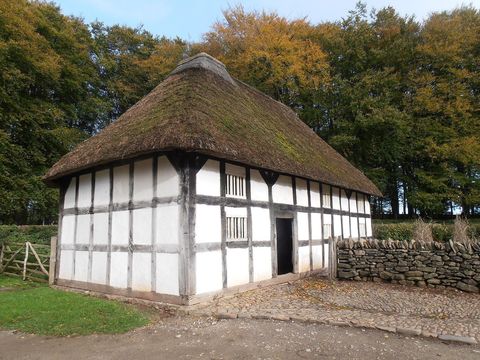
The Museum of Welsh Life, St. Fagans
There are museums and there are museums! Living history museums bring the past to life by holding time in aspic, taking us to an era of history in a you-are-there time machine.
Here are 10 destination-worthy visits that show us Britain as it was then—from Celtic roundhouses to textile mills.
The Living Museum of the North, Beamish, Durham

The Living Museum of the North, Beamish, Durham.
Pockerley Old Hall, the pit village, Rowley Station, Home Farm and the Edwardian town: Beamish delivers a delightful panorama of England’s North Country as it evolved from the agricultural economy of the 18th century to an industrial society 100 years later.
The Museum of Welsh Life, St. Fagans
Wales most popular heritage attraction and one of Europe’s leading open-air museums, St. Fagans’ mission is to recollect Welsh life from Celtic times to the present. From a village of Celtic houses to the Workman’s Institute, original buildings from across the centuries have been re-erected and animated by re-creators and artisans demonstrating traditional crafts.
Llancaiach Fawr, Nelson, Glamorgan
It’s the year 1645, the country is in Civil War, and King Charles I is coming to visit the Welsh Tudor manor of Llancaiach Fawr. The family and household staffs are busy in preparation for his call. You will need a letter of introduction to be welcomed to the house, but a servant will be happy to show you around.
Butser Ancient Farm, Chalton, Hampshire
Much more a laboratory than a museum, Butser is experimental archaeology, re-creating life as it was in Britain 2,000 years ago. They carry out serious experimental work in the agriculture, construction methods, and crafts of Celtic and Roman times. Fascinating.
Blists Hill Victorian Town, Ironbridge, Shropshire

Ironbridge, Shropshire.
The living face of Ironbridge Gorge (profiled in our July issue, p. 48), Blists Hill is a wonderful reincarnation of late Victorian life in the valley that birthed the industrial revolution. From the tellers at Lloyds bank to the music hall entertainment at the pub and the Victorian policeman patrolling the streets on bicycles, Blists Hill is a top-notch visit.
Historic Dockyard, Portsmouth

Portsmouth.
Britannia ruled the waves for centuries with her navy. Not strictly speaking a living history museum, Portsmouth incarnates a way of life. Visit Mary Rose, HMS Warrior, the National Museum of the Royal Navy, and the timeless seafront of Portsmouth harbor.
Black Country Living Museum, Dudley, West Midlands
More than 50 houses, shops, and workshops have been reconstructed in a canalside village depicting life in the Black Country during its industrial heyday. It describes itself as Britain’s Friendliest Open Air Museum; who’s to argue? You’ll discover there’s something deceptive in the phrase “Black Country.”
Quarry Bank Mill, Styal, Manchester
The textile mills of the midlands weren’t simply employment, they were a way of life. Read all about life at Quarry Bank Mill in our January 2012 issue, p. 46. Quarry Bank is one of the best visits depicting how industry changed life for the common folk.
West Stow Anglo Saxon Village, Bury St. Edmunds, Suffolk
West Stow reconstructs an early Anglo-Saxon village (circa AD 420-650) on the site where the original village was excavated. Ongoing archaeological work and a living interpretation of Anglo-Saxon life lets you smell the wood smoke and the pigs. The accompanying museum displays objects recovered during the excavation.
New Lanark, Lanark, South Lanarkshire
The beautiful restored 18th-century cotton mill village in southern Scotland is a World Heritage Site. Under the vision of Robert Owen, New Lanark became famous as a model industrial community. Journey back to 1820 with the ghost of mill girl, Annie McLeod.





Comments